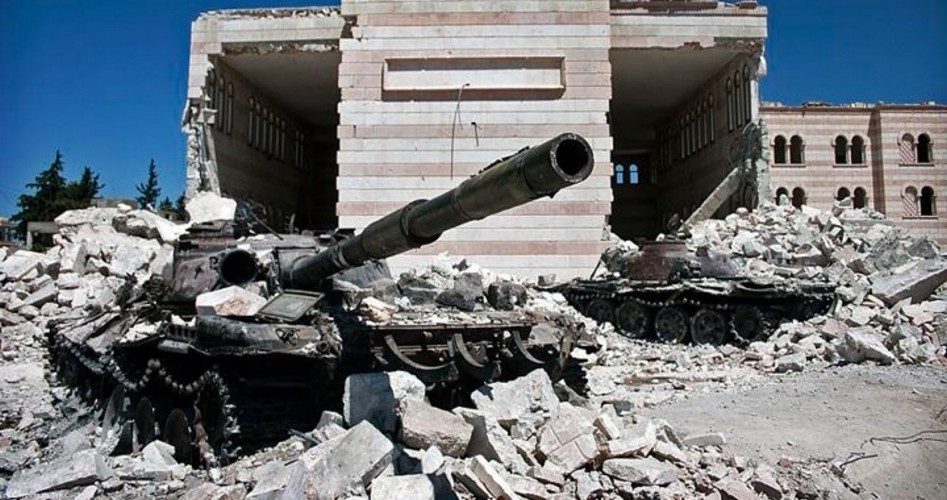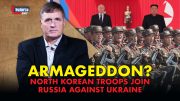
A new study by the International Monetary Fund (the IMF — the international banking consortium created at the United Nations Bretton Woods Monetary Conference in 1944 under the leadership of British Fabian socialist economist John Maynard Keynes and the senior American conference official and Soviet agent Harry Dexter White) stated that the economic impact of conflict in the Middle East and North Africa is “massive and persistent” and is responsible for soaring inflation, which hurts the value of currencies, and has resulted in a flood of refugees to neighboring nations.
The IMF report, entitled “Syria’s Conflict Economy,” presented the following key messages:
(1) The devastating civil war has set the country back decades in terms of economic, social and human development. Syria’s GDP today is less than half of what it was before the war started and it could take two decades or more for the country to return to its pre-conflict GDP levels; and (2) While reconstructing damaged physical infrastructure will be a monumental task, rebuilding Syria’s human and social capital will be an even greater and lasting challenge.
A Voice of America (VOA) news report on September 16 cited a statement by the IMF report’s authors noting that war has cut Syria’s gross domestic product by half, has shrunk Yemen’s economy by a quarter or more, and chaos and faltering oil prices reduced Libya’s economy by 24 percent in 2014. It also noted that conflict in the Gaza Strip and the West Bank has stalled economic growth for two decades, while the rest of the region advanced around 250 percent over the same period.
Furthermore, note the authors, the economic stress has traveled across borders with the 1.7 million refugees who fled to Europe, and the three million who moved to Turkey. Providing care for these refugees is putting serious strains on the host nations’ budgets and tolerance. The conflicts have also frightened tourists and investors away from the Middle East, which could significantly cut the region’s economic growth rate.
VOA also reported that the IMF study said that wise economic policies can limit the impact of conflict, but are difficult to implement.
The IMF report used a time-line approach to summarize events in Syria “Before the Conflict” and “Five Years Into the Conflict.” Bashar al-Assad assumed his position as president of Syria in July 2000, and the conflict (often referred to as a civil war) began in 2011. The report’s summary of life in Syria before the conflict actually makes Assad’s government look fairly effective, despite obvious shortcomings. It notes:
1. In the early 2000s, Syria embarked on a gradual economic liberalization to spur growth….
2. The economy was stable. Inflation was low and growth robust (non-oil growth averaged 4.4 percent during 2000–09)….
3. However, poverty and unemployment were on the rise. The 2010 Millennium Development Goals (MDGs) country report found that Syria was making progress toward several of the MDGs, including achieving access to universal primary education, reducing gender disparities in education, lowering child mortality, and improving immunization coverage of children. However, after falling between 1997 and 2004, poverty rose in the second half of the 2000s.
4. There were considerable regional disparities. Rural poverty indicators were much higher than urban and national indicators as the rural population did not benefit from the economic liberalization reforms, and farmers in particular were affected by a multi-year drought….
5. Syria also did not fare well on most business environment and rule of law indicators. In the 2009 Doing Business Indicators, Syria ranked 137 out of 181 countries, performing poorly on access to finance, contract enforcement, and registering property, while making progress on the time needed to start a business….
6. At the same time, political reforms were limited. President Bashar al-Assad initially advocated political reforms when he took over the presidency in 2000. However, the pace of reform was slow and frictions arose between those demanding reforms and those allied to the status quo.
The report’s summary of conditions in Syria “five years into the conflict” is lengthy, numbering its points from seven through 35. However, among its observations were:
“7. Starting in March 2011, Syria has witnessed an extremely violent civil war. The 2011 uprising has evolved into a crippling and violent civil war with fierce fighting between the regime and various secular and Islamist opposition groups in different parts of the country. Syria has politically disintegrated into autonomous provinces and territories controlled by the central government, Islamic State of Iraq and the Levant (ISIL), and various rebel groups…. The conflict has also attracted financial and military support from external powers.”
“8. The conflict has turned into a humanitarian disaster. The population of Syria (which stood at about 22.1 million in 2010) is estimated to have shrunk by at least 20 percent since March 2011….”
“9. Millions of people have been pushed into unemployment and poverty….”
“16. Oil and gas production has been severely disrupted and the well-developed energy infrastructure has been damaged….”
“19. Manufacturing production has likely suffered a disproportionately large decline. The sector has been affected by shortages in fuel, power, and other raw materials, limited access to trade finance, and severe destruction to infrastructure. The centers of Syria’s manufacturing base were in Aleppo, Homs, and the suburbs of Damascus — areas which have been most affected by the conflict….”
“29. Sanctions and the war have affected Syria’s financial system. Banks are largely isolated from the international banking market. As part of the international sanctions, the central and state-owned banks — which account for three-quarters of banking assets — are largely shut off from the international payment and settlement systems, as well as the credit markets.”
Since the IMF report did not explain the nature of these sanctions, we went to the website of the U.S. Embassy in Damascus, Syria, and found this information:
There are currently three types of sanctions that the U.S. government has imposed against Syria. The most comprehensive sanction, called the Syria Accountability Act (SAA) of 2004, prohibits the export of most goods containing more than 10% U.S.-manufactured component parts to Syria. Another sanction, resulting from the USA Patriot Act, was levied specifically against the Commercial Bank of Syria in 2006. The third type of sanction contains many Executive Orders from the President that specifically deny certain Syrian citizens and entities access to the U.S. financial system due to their participation in proliferation of weapons of mass destruction, association with Al Qaida, the Taliban or Osama bin Laden; or destabilizing activities in Iraq and Lebanon.
We might recall that the UN Security Council (of which the United States is a permanent member, with veto power) imposed stringent sanctions that amounted to a near-total financial and trade embargo against Saddam Hussein’s Iraq from 1990 until the U.S-led invasion removed Saddam in 2003. These sanctions were tied to the removal of Iraq’s alleged weapons of mass destruction, by Security Council Resolution 687.
On September 30, 2004, the U.S. Iraq Survey Group issued its Final Report, which stated: “The ISG has not found evidence that Saddam possessed WMD stocks in 2003, but [there is] the possibility that some weapons existed in Iraq, although not of a militarily significant capability.” (Emphasis added.)
Because of the large number of civilian deaths in Iraq that resulted from the sanctions, Denis Halliday, the UN’s Humanitarian Coordinator in Baghdad, resigned his post n October 1998 after a 34-year career with the UN in order to have the freedom to criticize the sanctions, saying: “I don’t want to administer a program that satisfies the definition of genocide.” Halliday charged that “two hundred thirty-nine thousand children 5 years old and under” had died from conditions such as malnutrition resulting from the sanctions, as of 1998.
We must also consider the ill effects that resulted from the U.S. removal of Saddam (something our government is trying to reprise in Syria by attempting to remove Assad). The plight of Iraqi Christians must be cited. Christians in Iraq numbered about 1,500,000 in 2003, but after the fall of Saddam (who had a Chaldean Christian right-hand man, Tariq Aziz), it was estimated that the number of Christians in the country had dropped to as low as 450,000 by 2013 — with some estimates placing the figure as low as 200,000.
After the 2003 invasion of Iraq, violence against Christians rose, with reports of abduction, torture, bombings, and killings. Some Christians were pressured to convert to Islam under threat of death or expulsion, and women were ordered to wear Islamic dress.
Another result of the removal of Saddam from power was the creation of a power vacuum that allowed ISIS to take control of large areas of the country, particularly the important city of Mosul. Even former British Prime Minister Tony Blair, who authorized British troops to support the 2003 invasion, told CNN last October that “there are elements of truth” to the view that the war in Iraq helped pave the way for ISIS.
While the IMF report noted in point number seven that “the conflict has also attracted financial and military support from external powers,” it did not mention that the U.S. government, by its support of what our State Department calls the “moderate” rebels fighting against Assad, has helped ISIS in Syria. Vice President Joe Biden, during a speech at Harvard last year, said: “The fact is, the ability to identify a moderate middle in Syria, um, was, uh — there was no moderate middle.” As a writer in The New American noted: “The entire notion that Obama and the U.S. government were arming “well-vetted moderate” jihadists in Syria to battle less-moderate jihadists is a fantasy — or a fraud. It was completely discredited by the president’s own deputy in a public speech!”
Biden blamed America’s allies in the Middle East, saying, “They poured hundreds of millions of dollars and tens, thousands of tons of weapons into anyone who would fight against Assad; except that the people who were being supplied were Al Nusra and al-Qaeda and the extremist elements of jihadis coming from other parts of the world.”
However, Biden left out one important point. He did not mention the role of the CIA and the State Department in the process of arming anti-Assad rebels who, in some cases, were allied with radical jihadists.
While the IMF report did an excellent job of summarizing the serious deterioration of conditions in Syria since the onset of the civil war there, observing that “Syria has politically disintegrated into autonomous provinces and territories controlled by the central government, Islamic State of Iraq and the Levant (ISIL), and various rebel groups,” it did not mention that U.S. support for the rebel groups has only served to exacerbate the problem. Though Assad is certainly not an ideal ruler (as Saddam was not an ideal ruler in Iraq), both men maintained stability in their respective countries and exhibited a willingness to work with Western governments and to maintain a Christian-friendly environment.
In an article reprinted by The New American last September, former Representative Ron Paul (R-Texas) identified what he thought was a key factor contributing to the vast exodus of refugees from Syria. The same factors, we might add, are responsible for many (if not most) of the problems challenging stability in Syria that were identified in the IMF report. Among the factors cited by Paul:
The reason so many are fleeing places like Syria, Libya, Afghanistan, and Iraq is that US and European interventionist foreign policy has left these countries destabilized with no hopes of economic recovery. This mass migration from the Middle East and beyond is a direct result of the neocon foreign policy of regime change, invasion, and pushing “democracy” at the barrel of a gun.
Even when they successfully change the regime, as in Iraq, what is left behind is an almost uninhabitable country.
Paul’s proposed solution was simple:
Here is the real solution to the refugee problem: stop meddling in the affairs of other countries. Embrace the prosperity that comes with a peaceful foreign policy, not the poverty that goes with running an empire. End the Empire!
Related articles:
Refugee Crisis: Using Chaos to Build Power
The Real Refugee Problem – and How to Solve It
Jackson Hole’s Gangsters and Banksters: What Are They Planning?



